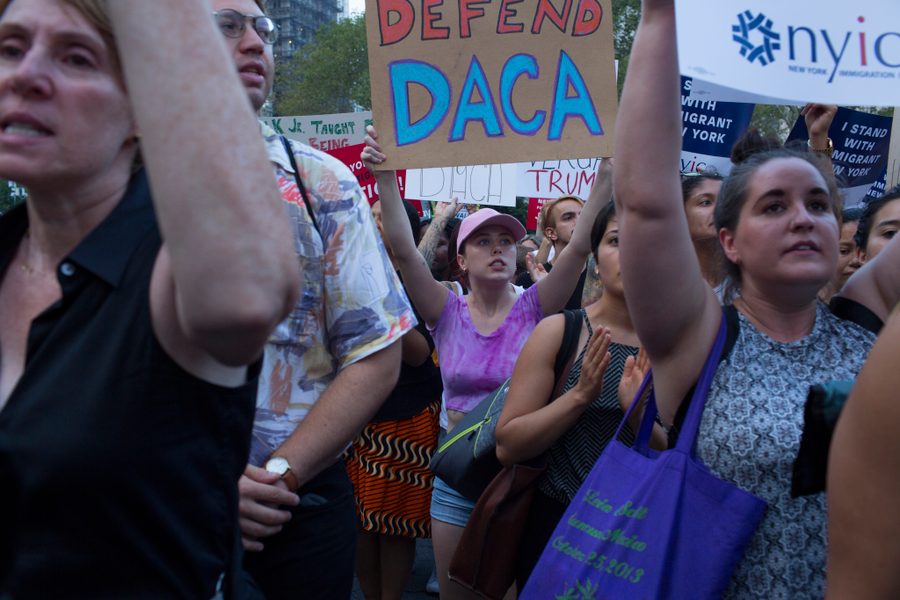Beyond DACA: The Youth Fighting for the Rights of All Immigrants
Movimiento Cosecha is taking direct action to defend DACA—and all undocumented people living in the United States.
Kate Aronoff

Jeff Sessions announced on Tuesday morning that the Trump administration is making good on a longtime promise: to end Deferred Action for Childhood Arrivals (DACA), a program that allows undocumented immigrants who came to the country as children to work and live in the United States without fear of deportation.
At the same time, hundreds of people gathered just blocks from Trump Tower in Midtown Manhattan for a rally called by Movimiento Cosecha, a group comprised largely of young, undocumented immigrants who stand to be among those worst impacted by this week’s decision. Over the next several hours, 34 “DACAmented” young people and their allies would be arrested.
“There were a lot of people crying,” Thais Marques, a DACA recipient and organizer with Cosecha, told In These Times. “We had to acknowledge that pain.”
Once the action got going, the tone shifted. “When we started marching to Trump Tower, and the DACA folks shut down Fifth Avenue, the mood completely changed,” Marques said. “It was really beautiful to see the strength that they have, and the courage, to do this literally moments after it was announced that DACA was repealed.”
Nine DACAmented demonstrators and three allies — one of whom was formerly undocumented — sat down on Fifth Avenue, blocking traffic briefly before being arrested. Organizers than led a march around the block, as another set of more than 20 protesters blocked the same street once again. Unexpectedly, several march marshals, charged with directing protesters, were arrested by the New York Police Department as well.
Well in advance of the action, organizers had agreed to use a tactic called jail solidarity, where people who are arrested refuse to be released until everyone from their group is free. Especially in protests involving undocumented activists, it’s a way to ensure those in more precarious legal standing aren’t singled out for special treatment — or entered into deportation proceedings.
Other Defend DACA actions were held in Grand Rapids, Mich. and Denver Colo., where hundreds of students staged a massive walkout. Several other protests were held in Southern California. As of Friday morning, youth with the Fair Immigrant Reform Movement and other groups entered the third day of a hunger strike in Washington D.C.
According to Marques, on Wednesday, “we saw a rebirth of the DREAM movement.”
Many Cosecha organizers were deeply involved in the ultimately unsuccessful fight to pass the DREAM Act at the national level, a push that formed a major part of what lead Obama to announce DACA via Executive Order in 2012. Marques is one of many in the immigrant rights movement, though, who are weary of perpetuating the idea that only DREAMers — and young, high-achieving students, in particular — deserve protection.
“We [at Cosecha] see ourselves as holding the line for constantly being dissatisfied with the narrative that we have to protect DREAMers and not the larger immigrant community,” Marques emphasized. “There’s no difference between DREAMers and workers. Our shared identity is that of workers. We all have a dormant economic power that the country depends on.”
As of 2016, there were an estimated 8 million undocumented people in the country’s workforce, and — in general — immigrants have a higher labor force participation rate than Americans born domestically. In certain industries, undocumented workers are represented in disproportionate numbers, comprising 17 percent of the agricultural workforce and 13 percent in construction. In California, people without papers account for 9 percent of all workers in the state.
Like many other progressive outfits, Cosecha experienced a huge spike in membership following Donald Trump’s election. The organization’s growth was spurred in part by its early adoption of the Sanctuary Cities frame, encouraging towns, college campuses and other institutions to refuse to cooperate with federal immigration authorities.
Ultimately, Cosecha hopes to build toward a general strike, though that could still be several years off. According to Cosecha’s strategy, publicly available on their website, a general strike is “Phase 4”. The second phase — the one they are in now — is political non-cooperation.
In the short-term, the group will look to be a disruptive voice and use more civil disobedience as the DACA conversation moves into Congress, which is now officially tasked with deciding the fate of the program. “The problem is that we are in a moment where we don’t really have negotiating power inside Congress or with Donald Trump,” Marques contended.
Given overwhelming GOP control, Cosecha is skeptical that any “clean” DREAM Act — one without an enforcement component — will make its way through Congress, when its earlier iteration failed during Obama’s tenure. “Any bill that is passed would probably include defunding sanctuary cities, building a wall and all sorts of other things that will be bad for our communities,” Marques explained, adding that Cosecha hope to refocus its efforts away from legislative back-and-forth.
“The only way Congress will pass something decent is if there are massive numbers of people in the streets,” she said. “We want to push people to not put their faith politicians. What has worked over the last 20 years in the immigrant rights movement is when undocumented people are demonstrating what risk and sacrifice look like.”
Kate Aronoff is a staff writer at The New Republic and author of Overheated: How Capitalism Broke the Planet — And How We Fight Back. She is co-author of A Planet To Win: Why We Need a Green New Deal and co-editor of We Own the Future: Democratic Socialism—American Style. Follow her on Twitter @katearonoff.








